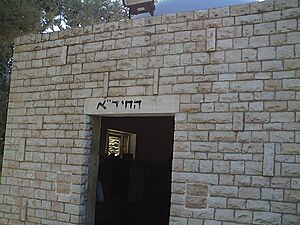Chaim Yosef David Azulai facts for kids
Quick facts for kids Haim Yosef David Azulai |
|
|---|---|
 |
|
| Religion | Judaism |
| Personal | |
| Born | 1724 Jerusalem, Ottoman Empire |
| Died | 1 March 1806 (aged 81–82) Livorno, Etruria |
| Children | Raphael Isaiah Azulai, Abraham Azulai |
| Signature |  |
Haim Yosef David Azulai (1724 – 1 March 1806) was a very important Jewish scholar. People often called him the Hida. This was a shorter way to say his name in Hebrew.
He was born in Jerusalem. He became a famous rabbi, a great reader, and helped publish many Jewish religious books. Some people think his family name, Azulai, comes from a special rule for Kohens (Jewish priests) in the Bible.
Contents
A Life of Learning and Travel
Hida was born in Jerusalem. He came from a well-known family of rabbis. His great-great-grandfather was Rabbi Abraham Azulai from Morocco. Hida learned from many important teachers in Jerusalem. He was very smart from a young age. By the time he was 12, he was already writing new ideas about Jewish law.
Traveling for a Cause
In 1755, Hida was chosen for a very special job. He became an emissary (called a shaliach or meshulach). This meant he would travel to different Jewish communities. His main goal was to collect money for the small Jewish community in the Land of Israel. These communities often struggled and needed help to survive.
Hida traveled across Europe three times (in 1755, 1770, and 1781). He visited many countries, including Germany, Egypt, Tunisia, Morocco, Italy, France, and Holland. Everywhere he went, he made a big impression. He was known for his deep knowledge and kind spirit.
During his travels, he looked at many old Jewish writings. He found and studied ancient books and papers. He wrote down what he found in his famous book, Shem HaGedolim.
In 1778, Hida married his second wife, Rachel, in Pisa, Italy. His first wife, also named Rachel, had passed away in 1773. Hida hoped to return to the Land of Israel, but he stayed in Livorno, Italy. He spent his later years publishing his many books. He passed away in Livorno in 1806. He had two sons, Abraham and Raphael Isaiah Azulai.
A Journey Home
In 1956, 150 years after Hida's death, there was a special plan. The Chief Rabbi of Israel, Yitzhak Nissim, wanted to bring Hida's body back to Israel. This was Hida's last wish.
In 1960, Hida's wish came true. His body was moved from Livorno to Har HaMenuchot in Jerusalem. A special memorial was built over his grave.
Hida's Amazing Writings
Hida was a very dedicated scholar. He studied the Talmud (a central text of Jewish law) and Kabbalah (Jewish mysticism). He also had an amazing memory. He was very interested in the history of Jewish religious writings.
When he was only 16, he wrote a book called Some Oversights. It was about solving questions in Jewish texts that seemed to have mistakes in their timelines. This book was never printed, but it showed his early talent.
Hida wrote a huge number of books. He wrote about almost every area of Jewish study. This included explaining the Bible, sermons, Jewish law, Kabbalah, prayers, and the history of Jewish literature. He read a lot and took notes on everything. When he traveled, he visited famous libraries to study old Hebrew manuscripts.
Shem HaGedolim
Hida's most famous work is Shem HaGedolim (The Name of the Great Ones). This book is like a dictionary of Jewish authors and their books. It has two parts: one lists authors, and the other lists book titles.
This book is very important because it saved a lot of information that might have been lost forever. Hida used careful methods to check facts. For example, he looked into whether Rashi (a famous medieval rabbi) really wrote some of the commentaries people thought he did.
Hida as a Traveling Emissary
Hida's role as a shadar (emissary) was a very important part of his life. He traveled far and wide on fundraising missions. He went as far west as Tunisia and as far north as Great Britain and Amsterdam. His main goal was to raise money for the Jewish community in Hebron, Israel.
At that time, Jewish communities in Israel faced many challenges. They suffered from high taxes and demands from local rulers. It was also hard to find work. Without the help of people like Hida, these communities might not have survived.
Being an emissary was a very difficult and dangerous job. The person chosen had to be smart, strong, and knowledgeable in Jewish law. They also needed to speak many languages. They had to be able to impress the communities they visited and help solve Jewish legal questions.
Travel in those days was much slower and more dangerous than today. Emissaries often had to be away from their families for years. Sadly, about one in ten emissaries never returned home. They sometimes even divorced their wives before leaving, so their wives could remarry if they died and their deaths couldn't be confirmed. If they returned safely, they would remarry their wives.
Hida wrote about the many dangers he faced in his travel diaries. He mentioned close calls with navies, pirates, and angry government officials. He also wrote about the daily risks of meeting people who were not friendly to Jews in Europe.
Hida's travel diaries are very special. They give us a firsthand look at Jewish life and historical events in Europe and the Near East during his time.
See also
 In Spanish: Jaim Yosef David Azulai para niños
In Spanish: Jaim Yosef David Azulai para niños


